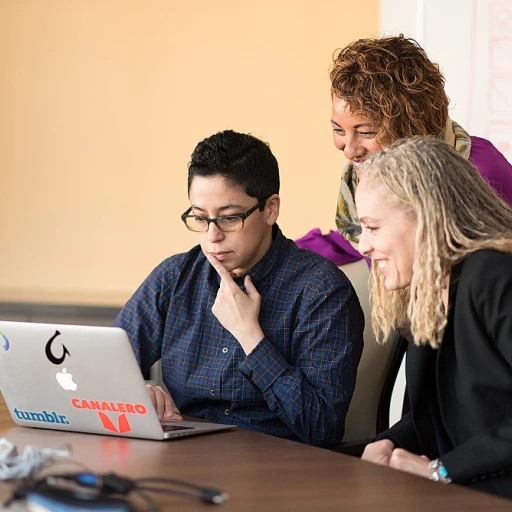
Understanding Team Augmentation
Unveiling the Concept of Strategic Expansion
Team augmentation is steadily gaining traction as a valuable approach to bridging skill gaps and ensuring project success. Unlike traditional outsourcing, team augmentation involves integrating external talent into in-house teams to work on projects alongside company staff. This augmentation model offers companies an opportunity to temporarily augment their staff with skilled professionals, bringing in software developers, project managers, and specialized expertise necessary to fulfill project requirements.
There is a growing understanding among businesses that accessing a broader talent pool through augmented teams can be key to rapid project advancement. The flexibility of this approach allows companies to align with project timelines efficiently and manage fluctuating demands effectively. By tapping into augmentation services, businesses are able to swiftly adapt to changing market needs without undergoing long-term commitments associated with full-time hires.
Team augmentation is a versatile model facilitating businesses’ need for specialized skills on a short term or long term basis. The capacity to integrate seamlessly with existing house teams can lead to enhanced collaboration and innovation, ultimately driving project outcomes towards success. This approach ensures that the development team is well-equipped with the necessary tools and skilled professionals to navigate complex projects, delivering results within specified timeframes.
Whether enhancing your project's capabilities for a specific phase or addressing short-term skill shortages, strategic augmentation can offer many long-term benefits as well. As we continue exploring the benefits and challenges of this model, the integration of augmented staff promises increased efficiency and improved project management capabilities.
For further insights into how team augmentation fuels business growth, consider exploring effective strategies in navigating talent mobility and its correlation with effective upskilling initiatives.
Benefits of Team Augmentation for Upskilling
Advantages for Developing New Skills Through Augmentation
Team augmentation is emerging as a powerful strategy for businesses looking to enhance their staff's skill set. When companies access a broader talent pool, it opens up diverse opportunities for upskilling their in-house team, which can have long-lasting impacts on productivity and innovation.
One immediate advantage is the access to skilled professionals who bring a wealth of project management and development experience. By leveraging these experts, companies can address specific project requirements effectively. This not only helps in filling skill gaps but also provides an opportunity for the current team members to learn from experienced professionals, effectively transforming the workplace into a dynamic learning environment.
Moreover, the integration of an augmented team allows for knowledge transfer that goes beyond the lifespan of individual projects. The house team can gain exposure to different methodologies, processes, and tools, crucial for ongoing software development efforts. This can significantly reduce the time needed to bring products to market and meet business targets.
The team augmentation model also proves to be a cost-effective solution compared to traditional outsourcing. By having the flexibility to scale up or down based on project needs, businesses can achieve their objectives without committing to long-term expenses associated with full-time staff.
For those interested in learning more about effectively building workforce skills, consider exploring enhancing skills in Katy's workforce as a valuable resource.
Challenges in Implementing Team Augmentation
Overcoming Hurdles in Team Augmentation
While the concept of team augmentation offers significant advantages for businesses aiming to upskill their workforce, it is not without its unique set of challenges. These challenges can affect the seamless integration of augmented staff into existing teams and impact the effectiveness of the augmentation model.
Firstly, integration issues can arise when new team members, whether they are full-time or part of an augmented team, do not mesh well with the in-house team. This can be attributed to differences in workplace culture, project management styles, or communication barriers. Overcoming these hurdles requires companies to foster an inclusive atmosphere where every team member, regardless of their tenure, feels valued and connected.
Another significant challenge is knowledge transfer. Ensuring that the expertise of augmented staff is effectively shared with the in-house team is paramount. Companies should establish proper channels and tools for collaboration to facilitate seamless knowledge transfer. Team leaders play a vital role in bridging skill gaps and ensuring that both the augmented and house teams are working towards the same project goals.
Moreover, companies often face logistical challenges in terms of managing time and resources efficiently. The usual project requirements may not always align neatly with the capabilities of the augmented staff. This can lead to inefficiencies or even project delays. To mitigate these issues, businesses can implement robust project management practices that allow for flexibility and adaptability during the integration of augmentation services.
Cost concerns also represent a common challenge. Although team augmentation is often touted as a cost-effective solution, the costs associated with frequent onboarding, training, and potential attrition of augmented developers can add up over time. As such, it is crucial for organizations to assess whether short-term or long-term augmentation aligns best with their business goals.
To explore how companies can strategically address these challenges and leverage team augmentation for upskilling, consider exploring the insights on enhancing skills for the South Plains Workforce.
Strategies for Effective Team Augmentation
Optimizing the Team Augmentation Model
When embarking on the journey of team augmentation, businesses are presented with an opportunity to optimize the integration of skilled professionals into their teams. Effective strategies are essential for leveraging the full potential of augmented teams and ensuring a smooth transition.
Defining Clear Objectives
One of the first steps is to clearly define the objectives of the team augmentation initiative. Understanding the specific project requirements and identifying skill gaps in the existing in-house team can streamline the process. Clear objectives not only guide the staffing of the augmented team but also set benchmarks for evaluating its success.
Streamlined Communication Channels
Communication is key in any successful team augmentation model. Establishing clear communication channels and protocols helps in mitigating the challenges associated with integrating an augmented team with the in-house staff. Regular meetings, feedback sessions, and updates ensure that all team members are aligned with the project goals.
Building a Collaborative Environment
Creating a supportive and collaborative environment is crucial for the success of an augmented team. Encouraging collaboration between the augmented staff and the dedicated team members can foster a sense of unity. By nurturing a culture of shared learning, companies can enhance the expertise of both the augmented and in-house teams.
Utilizing Appropriate Tools
The successful implementation of team augmentation also relies heavily on the use of appropriate tools and technologies. Project management software and collaboration tools can bridge the gap between teams, ensuring seamless integration and efficient project execution. These tools facilitate not only communication but also the tracking of project progress, making it a more coordinated effort.
Emphasizing Long-Term Development
While team augmentation often addresses immediate project needs, focusing on the long-term development of all team members is beneficial. Continuous upskilling and training can help retain the talent pool and prepare companies for future project requirements. By investing in augmented team members, businesses not only enrich their current projects but also build a robust workforce for future challenges.
Implementing these strategies thoughtfully can lead to significant improvements in team capabilities and project outcomes. By embracing a strategic approach, companies can unlock the full potential of team augmentation and achieve a harmonious blend of in-house expertise and supplemental talent.
Case Studies: Successful Team Augmentation
Illustrative Examples of Successful Collaborations
In order to truly grasp the potential of team augmentation, examining real-life examples can provide valuable insights. The following cases highlight how companies have strategically leveraged augmented teams to drive upskilling and business success.Tech Firm Expands Capacity with Specialized Skills
A leading tech firm faced challenges due to rapid growth and evolving project requirements in software development. By opting for team augmentation, they were able to access a specialized talent pool of expert developers seamlessly integrated into their in-house team. This dedicated team model allowed the company to meet project deadlines without compromising quality, effectively bridging skill gaps in their existing staff. The transition to augmented staff brought long-term benefits by bolstering the team's capabilities, ultimately enhancing project management efficiency and development time.Outsourcing Giant Adopts Augmentation for Flexibility
A renowned outsourcing company had a fluctuating workload, which sometimes required more resources than their existing teams could handle. They adopted an augmentation model to scale their operations on a short-term basis. By hiring augmented team members, the company managed to maintain flexibility without the commitment and costs associated with a full-time expansion. This approach allowed them to adjust quickly to market demands while simultaneously offering development opportunities to their staff, thereby increasing their internal expertise.Healthcare Provider Boosts Innovation through Augmented Staff
In the healthcare sector, a forward-thinking organization sought to innovate its digital services. By engaging in augmentation services, they collaborated with talented professionals possessing niche expertise essential for developing next-gen solutions. This enriched collaboration fostered knowledge transfer between in-house teams and augmented teams, leading to groundbreaking advancements in their digital offerings. The partnership also enabled the healthcare provider to focus its core staff on strategic initiatives, optimizing both time and resources.Financial Services Company Overcomes Skill Gaps
Facing a skill gap in fintech solutions, a financial services company embraced an augmentation project to access skilled professionals adept in cutting-edge technologies. Through this staff augmentation arrangement, the company swiftly filled crucial expertise voids without compromising on project timelines. The cooperation between the permanent staff and external experts provided the necessary spark for innovative ideas while also upskilling internal team members.E-commerce Business Drives Cost-Effective Expansion
An e-commerce business, intent on expanding operations, chose a strategic augmentation model to support its growth. By engaging with augmented teams, they effectively leveraged the global talent pool, which proved to be not only cost-effective but also instrumental in introducing new services. This collaboration facilitated fast-paced development cycles, enabling the business to launch new projects, all while honing the skills of their core in-house staff for future undertakings. These practical examples underscore the multitude of ways team augmentation can optimize a company's operations, empower skill enhancement, and adapt dynamically to the ever-changing business environment.Future Trends in Team Augmentation and Upskilling
Emerging Technologies and Their Impact on Team Augmentation
The future of team augmentation is closely tied to the rapid evolution of technology. As companies increasingly adopt advanced software development tools and platforms, the demand for skilled professionals who can navigate these technologies is on the rise. This shift is driving businesses to seek out augmented teams that bring specialized expertise to the table, ensuring they stay competitive in a fast-paced market.
Integration of AI and Automation
Artificial Intelligence (AI) and automation are becoming integral components of the team augmentation model. These technologies can streamline project management processes, enhance productivity, and reduce the time required to complete projects. By integrating AI, companies can optimize their augmented staff, allowing them to focus on more complex tasks that require human creativity and problem-solving skills.
Remote Work and Global Talent Pool
The shift towards remote work has expanded the talent pool available to businesses, making it easier to access skilled professionals from around the world. This trend is particularly beneficial for companies looking to fill skill gaps in their in-house team. By leveraging remote work capabilities, businesses can build dedicated teams that are both cost-effective and highly skilled, without being limited by geographical boundaries.
Focus on Long-Term Partnerships
While short-term projects remain a staple of team augmentation, there is a growing emphasis on establishing long-term partnerships with augmentation services. Companies are recognizing the value of building relationships with trusted partners who understand their business needs and can provide consistent, high-quality talent over time. This approach not only enhances team capabilities but also fosters a deeper integration of augmented staff into the company culture.
Continuous Upskilling and Development
As the business landscape continues to evolve, continuous upskilling and development will be crucial for both in-house and augmented teams. Companies must invest in training programs that keep their staff updated with the latest industry trends and technologies. This commitment to learning ensures that teams remain agile and capable of meeting changing project requirements effectively.












